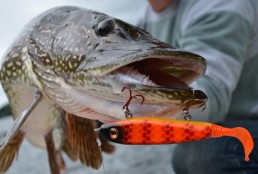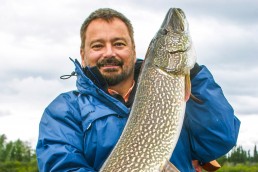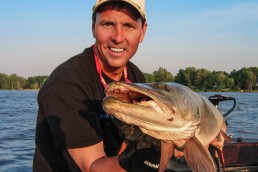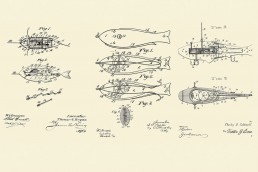Bigger Lures Catch Bigger Pike—Mostly!
SHARE THIS POST
In the June issue of MidWest Outdoors, we discussed the how to determine the depth range of big-pike activity and the overall use of larger lures that appeal to the greedy nature of trophy pike. At least part of the time, it’s not enough just to fish where the fish are; sometimes, you have to stretch yourself to the limit, going overboard with the use of very large lures to trigger a response.
Why? Well, it probably comes down to the fact that big pike prefer to eat something about 1/3 the length of their body, if possible, to make chasing it down and catching it worth their while, energy-wise. Dining on one or two—or a few—larger baitfish is far more energy efficient than running down and gobbling school of smaller baitfish. Heck, big pike are actually scavengers part of the time—especially in cold water—and are likely to pick up and eat a dead sucker, smelt, cisco, goldeye or shad off the bottom. So, the old adage, “Big fish—big bait” certainly applies. 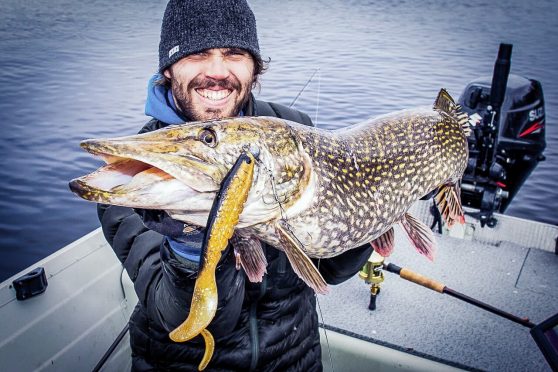
In effect, when you think about pike-sized lures…think again. A 20-pound pike, which generally runs about 42 inches in length, give or take, would theoretically find a 14-inch lure far more appealing than a 4-inch crankbait. Admittedly, finding a 14-inch lure, and then being able to cast and retrieve it, is perhaps more of a challenge than catching the fish itself! They pretty much don’t exist. Thus, the best bet is to simply go as big as practical, lure-wise. Much of the time, if you upsize to muskie-sized lures, you’re more in the ballpark.
However, not always.
Large wobbling spoons like 4-inch-ish Dardevles and Len Thompson #2s and 4s are undoubtedly some of the most effective pike lures in Canadian waters. But if you go all the way up to a 5 ½- inch Huskie Devle, well, that has so much of an exaggerated wide wobble that it’s probably a better lake trout spoon, at least in my opinion. A 4 ½-inch Huskie Junior or something a size smaller would be more pike-ish, if for no other reason that just to tone down the mega-wobble.
Large, 7- or 8-inch streamers or rabbit fur leech imitations are very deadly when you need to tempt big pike to bite in the face of fishing pressure or unstable weather conditions. They’re big, and you can hover them in place due to their near-weightless nature. Even the biggest pike find them hard to resist.
Muskie baits in all types—bucktail spinners, safety-pin spinnerbaits, crankbaits, large jigs with plastic tails, etc.—are all commercially available easy to track down and purchase, as well as use.
Are you enjoying this post?
You can be among the first to get the latest info on where to go, what to use and how to use it!
In fact, the exploding popularity of large soft baits across the muskie market in the last 10 to 15 years offer great potential for catching bigger pike. I vividly recall a 20-pounder swimming up from behind and swallowing a big Bull Dawg tail-first at boatside. The bait was just plain gone, way down in its throat. If a huge bait like that gets popped like a gum drop, it shows that there’s no aversion to a heft hunk of soft plastic that acts and looks good enough to eat.
Now, all of that being said…definitely don’t sell all of your normal-sized pike baits at your next garage sale. Sometimes, for whatever reason—cold fronts, they’ve been caught and released before, etc.—pike prefer a morsel to a meal or a mouthful. You just plain never know. So, you carry it all along with you, experiment with lure size as well as style, and hope for the best. But in general, given the opportunity, start to err a bit on the high side, upping your lure size to up the odds for bigger pike.
Dave Csanda has enjoyed 40 years in te fishing communications industry at In-Fisherman, Angling Edge and now, as editor of MidWest Outdoors. He is an inductee of both the Minnesota and National Fresh Water Fishing Halls of Fame.
MWO
SHARE THIS POST
Did you enjoy this post?
You can be among the first to get the latest info on where to go, what to use and how to use it!
Dave Csanda
Dave Csanda has enjoyed 40 years in the fishing communications industry at In-Fisherman, Angling Edge and now, as editor of MidWest Outdoors. He is an inductee of both the Minnesota and National Fresh Water Fishing Halls of Fame.
